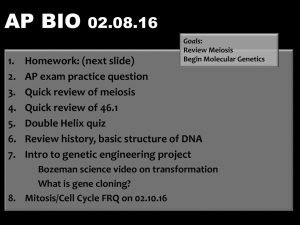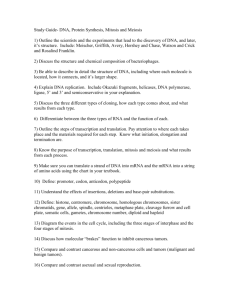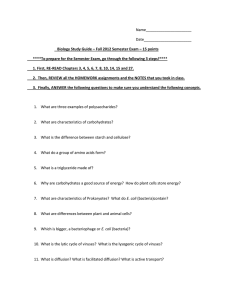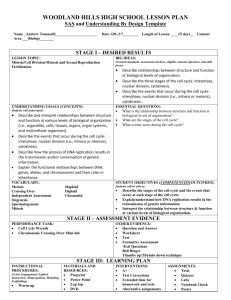NATS 104 LIFE ON EARTH Section: _______ SPRING, 2004
advertisement
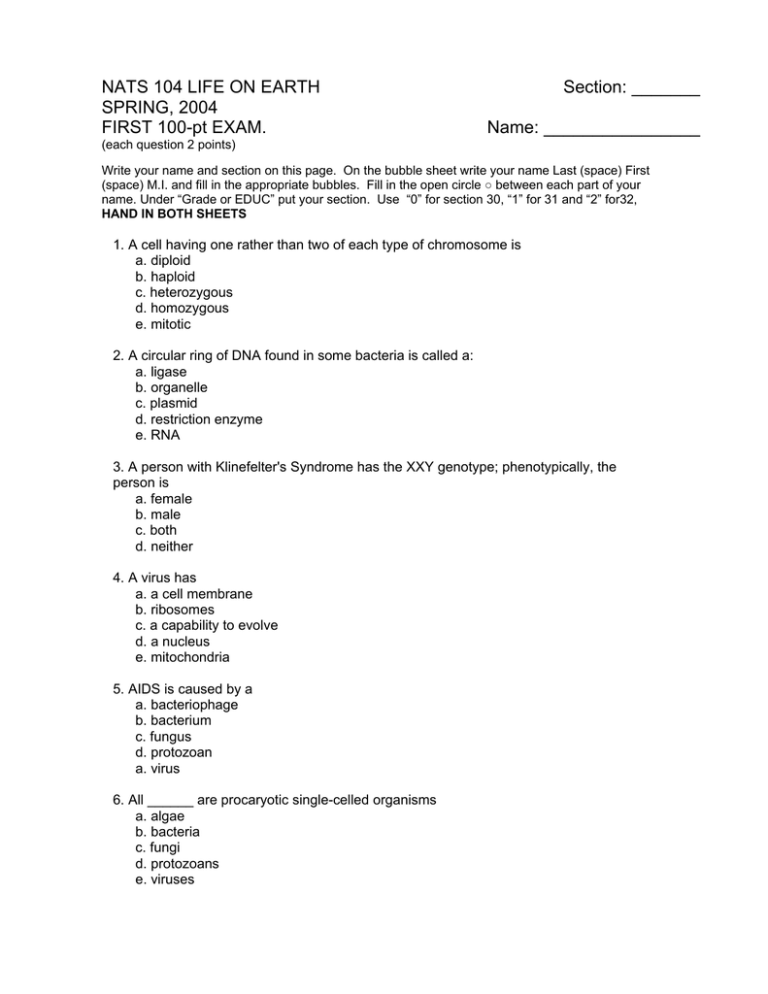
NATS 104 LIFE ON EARTH SPRING, 2004 FIRST 100-pt EXAM. Section: _______ Name: ________________ (each question 2 points) Write your name and section on this page. On the bubble sheet write your name Last (space) First (space) M.I. and fill in the appropriate bubbles. Fill in the open circle ○ between each part of your name. Under “Grade or EDUC” put your section. Use “0” for section 30, “1” for 31 and “2” for32, HAND IN BOTH SHEETS 1. A cell having one rather than two of each type of chromosome is a. diploid b. haploid c. heterozygous d. homozygous e. mitotic 2. A circular ring of DNA found in some bacteria is called a: a. ligase b. organelle c. plasmid d. restriction enzyme e. RNA 3. A person with Klinefelter's Syndrome has the XXY genotype; phenotypically, the person is a. female b. male c. both d. neither 4. A virus has a. a cell membrane b. ribosomes c. a capability to evolve d. a nucleus e. mitochondria 5. AIDS is caused by a a. bacteriophage b. bacterium c. fungus d. protozoan a. virus 6. All ______ are procaryotic single-celled organisms a. algae b. bacteria c. fungi d. protozoans e. viruses 7. All of the following cause human diseases EXCEPT: a. Archaea b. Fungi c. Prokaryotic bacteria d. Protzoans e. Retroviruses 8. Atoms are made of the following EXCEPT a. Electrons b. Neutrons c. Molecules d. Protons 9. Cell membranes consist mainly of a. carbohydrate bilayer and proteins b. cellulose bilayer and carbohydrates c. lipid bilayer and proteins d. protein bilayer and lipids e. ribonucleotide bilayer and lipids 10. The early atmosphere of the Earth (4.7-3.8 billon years ago) contained all the following gases in abundance except: a. CO2 b. H2O c. N2 d. NH3 e. O2 11. Cells that have organelles are called: a. viruses b. eukaryotes c. prokaryotes d. lipids e. chromosomes 12. During which stage of meiosis do analogous chromosomes separate? a. anaphase 1 b. anaphase 2 c. metaphase 1 d. metaphase 2 e. telophase 1 13. How many nucleotides are in an RNA codon? a. 1 b. 2 c. 3 d. 4 e. 5 14. If you took your temperature 10 times and got the exact same result each time, your data is: a. accurate b. a fact c. a theory d. precise e. true 15. In humans, gender is determined by the a. X chromosome b. XX chromosomes c. X & Y chromosomes d. Y chromosome e. YY chromosomes 16. In the carbon cycle diagram (right) the atmospheric carbon reservoir is changing by ____ petagrams per year a. -50 b. -10 c. 0 d. 10 e. 50 17. In this photosynthesis equation: H2O + ??? => CH2O + O2, the missing substance is a. CH3 b. CO2 c. H20 d. NO2 e. O2 18. Crossovers and inversions occur during a. interphase b. fertilization c. mitosis d. meiosis e. photosynthesis 19. Leibig's Law states that the most important nutrient in a system is the one a. closest to the optimum for the producers that system b. highest on the food chain of consumers in the system c. in least abundance relative to the needs for that system d. with the greatest charge for molecules in the system e. with the shortest nutrient cycle of that system 20. Mitosis is a process that results in: a. combination of gametes b. combination of two cells to produce a zygote c. division a single cell to produce two identical cells d. multiplication of gametes e. production of gametes 21. Molecules are made of __________ held together by __________ a. atoms - bonds b. ions - electrons c. neutrons - energy d. polymers - attraction e. protons - charge 22. Nucleic Acids are the building blocks of a. carbohydrates b. DNA c. fat d. protein e. sugars 23. Humans have drastically impacted this nutrient cycle, especially after the invention of the Haber-Bosch Process. Currently, more of this nutrient is fixed by artificial means than by nature. a. carbon b. hydrogen c. nitrogen d. oxygen e. phosphorous 24. Polymers are made of basic building blocks, which are a. atoms b. cells c. electrons d. molecules e. neutrons 25. Procaryotic cells do not have __________, but eucaryotic cells do. a. cell membranes b. DNA c. mitochondria d. ribosomes e. RNA 26. __________ produces RNA from DNA a. Meiosis b. Mitosis c. Replication d. Synthesis e. Transcription 27. Protein synthesis usually takes place on _____ in the _____ a. DNA - ribosomes b. mitochondria - cytoplasm c. mitochondria - ribosomes d. ribosomes - cytoplasm e. ribosomes - mitochondria 28. Starches are biopolymers of a. amino acids b. fatty acids c. nucleotides d. sugars e. waxes 29. Refer to the figure to the right: The amount of carbon in the biota is a. constant b. decreasing c. increasing d. greater than the amount in the atmosphere e. greater than the amount in the soils 30. Regarding the scientific method, what kind of reasoning is used to develop a particular test, based on a general hypothesis? a. deductive b. hypothetical c. inductive d. reductive e. theoretical 31. __________ produces identical chromatids a. meiosis b. mitosis c. replication d. synthesis e. transcription 32. Sexual reproduction involves the combination of gametes, the gametes result from the process of __________. a. fertilization b. meiosis c. mitosis d. photosynthesis e. respiration 33. The 64 possible combinations of nucleic acids in a codon code for the ____ common amino acids found in living organisms. a. 16 b. 20 c. 40 d. 64 e. 120 34. The correct taxonomic name for living humans is a. Homo sapiens b. homo Sapien c. Homo sapien d. homo sapiens e. Homosapien 35. The figure at the right represents a building block of a. DNA b. Fat c. Protein d. RNA e. Starch 36. The following elements are the most important nutrients for life, and make up 99% of all biological material EXCEPT a. C b. Fe c. N d. O e. P 37. The oxygen of the Earth's atmosphere has accumulated through a. oxidation b. photosynthesis c. radioactive decay d. respiration e. sexual reproduction 38. The phase of mitosis during which the chromatids are at opposite poles of the cell is: a. anaphase b. interphase c. metaphase d. prophase e. telophase 39. The allele is that is NOT expressed when present with another allele a. genotype b. heterozygous c. homozygous d. phenotype e. recessive 40. Water (H20) is an example of a(n) a. atom b. carbohydrate c. element d. molecule e. polymer 41. What are well-tested explanations accepted by most of the scientific community? a. hypotheses b. laws c. models d. systems e. theories 42. What brings amino acids to the ribosome? a. tRNA b. rRNA c. mRNA d. sRNA e. DNA 43. What is the genotype of individual 3 (table at right)? a. LLTT LT b. LlTT Lt c. LLtt d. llTT lT e. lltt lt 44. Which is a characteristic of any balanced (stable) system? a. All reservoirs are of equal size b. Input into reservoirs equals output from the reservoirs c. The number of reservoirs equals the number of inputs d. The population of each species is equal e. The population of each species is stable LT 1 Lt lT lt 2 3 4 45. Eucaryotic cells originated about __ billion years ago through __ a. 0.5 - aerobiosis b. 1.2 - endosymbiosis c. 3.2 - mitosis d. 3.8 - photosynthesis e. 4.3 - respiration 46. Which of the following is a correctly written formal name for grizzly bear? a. ursus horribilis b. Ursus Horribilis c. Ursus-horribilis d. Ursus horribilis e. Ursus horribilis 47. Which of the following is a gauge of how well a measurement matches the true value? a. accuracy b. precision c. probability d. repeatability e. stability 48. Which of the following is NOT a characteristic of all life. a. Cells b. Evolution c. Organelles d. Photosynthesis or Respiration e. Reproduction 49. Which of the following pairs is found in BOTH prokaryotic and eukaryotic cells? a. Cell membrane & Nucleus b. Organelle & Cell membrane c. Organelle & Nucleus d. Ribosome & Cell membrane e. Ribosome & Nucleus 50. Which of the following polymers is correctly paired with the building blocks that combine to make up the polymer? a. DNA - Amino Acid b. Fat - Sugar c. Protein - Fatty Acid d. RNA - Nucleic Acid e. Starch - Amino Acid
